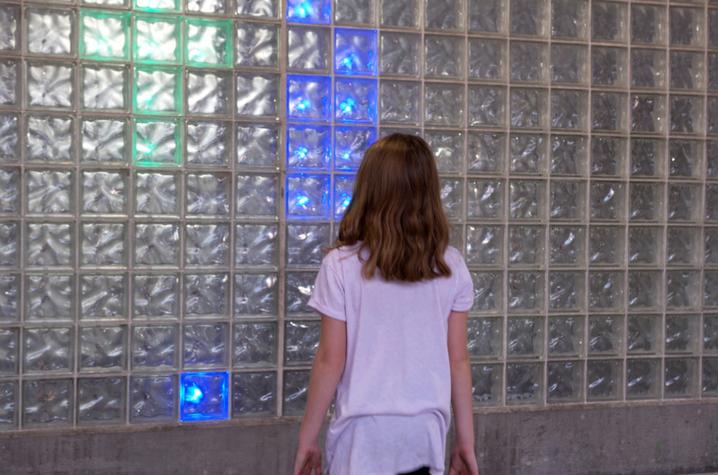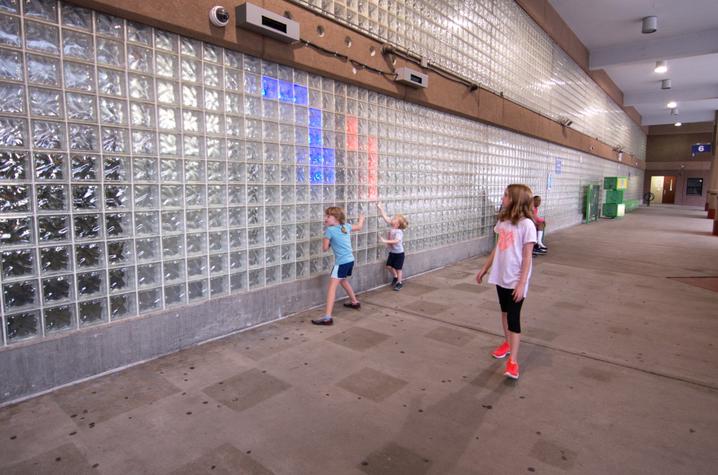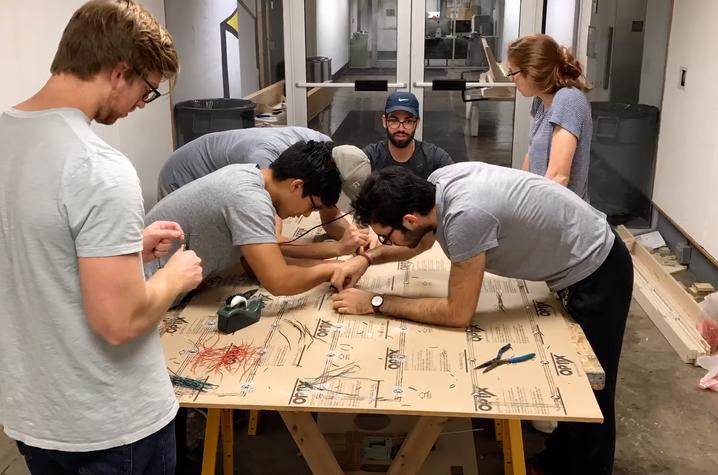UK Design LED Installation Transforms Bus Station to Play Station
LEXINGTON, Ky. (Sept. 28, 2017) — Play is important to childhood development, exercising a child’s imagination, cognitive skills and physical strength.
A new space in downtown Lexington recognizes this need and has turned a less obvious venue into a play area for kids passing through the facility. Beginning this summer the downtown Lexington Transit Center has added several new interactive kid-friendly designs thanks to funding through a recent Play Everywhere Challenge grant. The Lexington Downtown Development Authority was awarded the grant and worked with Lextran and LEXPARK to bring play into everyday life at this hub of activity. They reached out to local designers, including the University of Kentucky College of Design, to plan the new kid-friendly elements.
The intention of the Play Everywhere Challenge is to provide play for children at locations like bus stops, laundromats and empty lots where children are in their everyday life.
“We know from the Lextran Ridership survey, that people spend up to an hour sometimes getting to and from their locations in Lexington. And we just wanted to make the 10- to 15-minute wait for those families a little bit safer, and nicer, and fun,” said Hannah O’Leary, a project analyst with the Lexington Downtown Development Authority (LDDA), which works on economic development and public space projects within downtown Lexington.
“Public design can have a great impact on the quality of life every single day,” O’Leary added. “And it's our job as the Downtown Development Authority to make sure that these public spaces that everyone can benefit from in our community are not overlooked and receive the benefits of this type of design.”
To help make the play space a reality, LDDA contacted local design firms and the UK College of Design for ideas on how to add creative installations for kids to a utilitarian bus station that serves up to 5,000 people each day.
In addition to Lexington firms Nomi Design and Informal Office, Jason Scroggin, associate professor of architecture at UK, answered the call. Scroggin is known by many for his large-scale designs, some in animal forms, with which people are encouraged to interact.
But the bus station design posed new challenges for Scroggin and his studio of students.
“You have less than 20 feet in width to work with, and a lot of that is used for circulation. Typically, in the course that I teach, we'll make large-scale objects for people to really interact with, jump on, go inside, climb on, etc. That's kind of where we started with our design proposals, but we found out relatively quickly that that wouldn't work because, besides the fact that these pieces wouldn't fit inside the space, they would be hazardous,” Scroggin said.
While Scroggin’s UK studio met with Lextran’s risk management director and Lextran and LEXPARK management teams to get a better understanding of the potential risks of activity on a concrete platform, the challenging design space spurred the UK students’ creativity. Students who participated in the research and development process as part of ARC 599: Fabricating Play included: Clayton Arrowood, Michael Foster, Pooya Mohaghegh, Brandon Nelson, Joshua Powell, Luke Ramler, Tricia Rowedder and Joshua Schultz, as well as Michael Pina of the College of Engineering.
In the end, three designs were selected to help make the bus station more family friendly, including an LED light wall installation from Scroggin’s studio. “One Light, Two Light, Red Light, Blue Light” took advantage of the station’s glass block wall between the terminal and parking garage.
“The way it's situated, there's the bus terminal on one side of this 500-foot-long space, and on the other side, it's all parking garage. And the glass block wall divides the two spaces,” Scroggin said. “We looked at that as an opportunity to, you know, light something up.”
Students worked day and night and identified various campus resources to figure out how to add programmable lighting to the wall that would react to movement and create lighted “stick figures” that would mimic the movement.
“We ended up spending a lot of time, late at night, from maybe midnight to 3 or 4 a.m., preparing the boards, soldering them, programming it, testing it. If you have an idea on campus, there's someone who knows how to help you do it. So, we didn't know a lot of the things, but we went to the different departments of engineering, and they did know how to do it, so we got help from them. Collaboration was very, very important in this project,” said Pooya Mohaghegh, a 2016 architecture graduate from Tehran, Iran.
Mohaghegh’s classmate Tricia Rowedder, a current graduate student in architecture from Rockville, Maryland, who earned her bachelor’s degree in architecture from UK in May 2017, smiled when asked about the finished product. “My favorite part I think is the outcome — actually getting to go down onto the site and interact with the lights. Every time we go down, we see our stick figures reflecting on the wall and it's a lot of fun, because it is a project for all ages — whether you're a little kid or a grown adult.”







